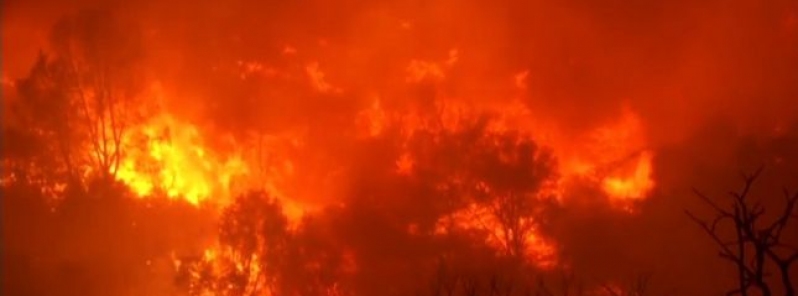65 000 acres burned down in only a few days, as wild fire blaze spread across northern California

An explosive wildfire which started on September 8, 2015, has forced 2 700 residents across the northern California to evacuate by September 11. A state of emergency was declared by California Governor Jerry Brown, as more than 1 500 firefighters have been dispatched across the affected areas.
About few hundred acres (about 40 hectares) have been burnt down in the counties of Amador and Calaveras by the "Butte" Fire on September 10, 2015. The area affected rapidly increased in only a few days to 65 000 acres (26 305 hectares), as of September 12. The fire is only 5% contained currently and evacuations have been ordered across the San Andreas town.
Video credit:ABC7
Since an explosive start on September 8, the fire has been spreading uncontrollably toward the south and east: “It’s exploding like a balloon. It’s moving very fast. There are many homes threatened. … This fire is extremely dangerous,” state fire spokeswoman Nancy Longmore said.
State of Emergency declared in 50,000-acre Butte Fire in NorCal; Thousands evacuated http://t.co/SbocseGCPi pic.twitter.com/RInsb1twvZ
— KTLA (@KTLA) September 12, 2015
6 homes and 2 outbuildings were devastated by the fire, and 6 000 more have been threatened by the fast spreading blaze, since September 10.
Three evacuation centers have been set up so far, to aid the victims. Over 1 500 firefighters, 178 engines, 7 air tankers and 16 helicopters were assigned to fight the fire.
DETAILS: Only 10 percent of the fire contained, 8 structures burned already (via @EdJoyce) http://t.co/SoVc7duo36 pic.twitter.com/848m6vyxVz
— RT America (@RT_America) September 12, 2015
Weather conditions over the next few days might be helpful in battling the spreading fires, however, as September is one of California's driest months, no long-term relief is still in sight, according to weather.com meteorologist Jonathan Erdman.
"The week ahead offers some relief in the form of cooler air and higher humidity, but the chance of rain looks remote. September is still one of California's driest months; the wet season usually doesn't kick in until November. A stray afternoon thunderstorm can't be ruled out, however, which could produce dangerous shifting winds if occurring near the fire."
Featured image: Fire blazing across northern California. Image credit: ABC7

Something to remember, after forest fires, especially those fires that burn “hot”, the soils take on a hydrophobic quality. That is to say, they become almost water repellent, with rain beading up and rolling off quickly to the lowest point. This will mean even more destructive flooding than normal.
Consider the fact in California alone, if you include acreage that burned in 2014 and 2015, this would be almost a million acres that have those qualities. The Chaparral understory, when burned, also adds oils that even increase the runoff even further. The total acreage burned in the Western US is more than 7 million acres.
This being the year of a massive El Nino, it’s safe to say with dry hydrophobic soils the runoff will be unprecedented. In the past, the US Forest service as well as the US Bureau of Reclamation, and State and local governments, have been leery of interference of watersheds and stream flow alteration and mitigation. This policy as well as budget cutbacks mean there will be no proactive steps taken before the rains saturate the soils, thus setting the stage for environmental impacts that are unprecedented.
The economic losses, I suspect will be impressive. The Governor of California, I hope will anticipate all this, as the pre planning for disaster services and funding need to be updated, examined, and anticipated.